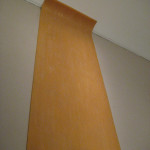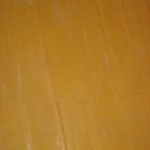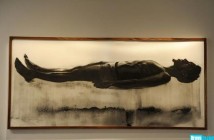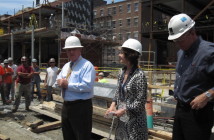TALKING ABOUT PLACE WITH RACHEL WHITEREAD
Rachel Whiteread was in town for the opening of her U.S. premiere of her new piece Place (Village) at the Museum of Fine Arts, Boston. I was lucky enough to spend a few minutes with her. We chatted about her new work, her old work and a little bit about Bruce Nauman. The exhibition is up until January 25th of next year. It is worth a trip on the "E" train.
James Nadeau: So, what I wanted to focus on is process. It seems like there is a dramatic shift, not so much conceptually, but formally with the new work.
Rachel Whiteread: Yeah, you know as I tried to explain earlier, when I made Embankment, the shift happened then actually. You know, the fourteen thousand boxes were cast in polyurethane and they were... the original boxes were made by me. And then we had to make aluminum molds of those.
JN: So you had to make templates?
RW: Yeah, and then we gave them to a factory and then they produced all of these boxes. That was the first time where something was kind of three times removed from me actually having to do it in the studio. And then I had these 14,000 boxes turning up at the Tate and I had to organize them into something, which I did. But through that process, I think, it kind of freed me up. I think that as an artist you learn to speak a certain language with a vocabulary that you decide upon. And the vocabulary can be as limited or as vast as you want it to be. But I think you can also get stuck and I'm not saying that's a bad thing. Actually I think that some of the best artists in the world simply just work within extremely limited vocabulary. Basically I think just try to expand on that vocabulary a little bit, thinking about a number of issues. I think with that piece particularly having made Embankment, it was something that freed me up in terms of the boxes and the organizing of stuff, piling things up and just thinking about a landscape rather than an object.
JN: Did it feel like more of a purge then? It is almost like the explosion of the form.
RW: Yeah, it was kind of liberating, I think, to be able to do that. Which was interesting. You know, and also I think, with the piece, it was sort of the opposite of everything I have done. It was illuminating something from the inside rather than filling something up, filling an inside up. So, I think it was a kind of more playful side of something I might do. But I'm still making objects. I'm actually using color; a lot more color now in my new work. Which I probably think his also come from that.
JN: This is the work that was at Gagosian, the Drill pieces?
RW: Oh, the tubes? Yes, exactly. There is a lot more color with those.
JN: It is interesting in looking across the breadth of your work there is a real sense of intimacy, especially with the early pieces. With the work here, it is an interesting transference where you are capturing these intimate spaces but they are encapsulated in these houses that you didn't create. But by gathering them and putting them in the space and building them around each other it is an entirely different act of building intimate spaces.
RW: Yes, exactly.
JN: What were your goals with Place? I know it is about the act of collecting but...
RW: Well, it came from an act of collecting. There's something about collecting something on such a scale. Which is interesting. It's interesting in the chase of the object, to find something, which I've always enjoyed actually. It's always been a part of the work. It is somehow connecting with where the piece originally came from. That's always been the interesting part of it. It's fascinating how, cause a lot of the stuff I buy on the Internet, it's fascinating how the stuff arrives and the way its packed. Often these houses are packing in house shaped packaging where people just use cardboard boxes and loads and loads of brown tape and I took an enormous amount of photographs of these things in my studio because that was also a part of it. And the fact that I've been using boxes to cast so I've actually cast some of the boxes that these dollhouses came in. It still has that same obsessive quality and the cyclical way I've always worked.
JN: And there is the performative aspect about it as well. Where this is the end result of this huge performance that you've been...
RW: Yeah, well, in a way. I showed this earlier in the year at the Haywood in London and that was more so because I didn't know how it was going to be installed. But knowing that the space here was almost identical in size once I had installed it there I could send my assistants out with a very clear plan if I had to do it again.
JN: So it is much more thoroughly mapped out now?
RW: Yes, yea. But you know next time it is shown it will be at another place and it will be completely different.
JN: Do you like that aspect of it?
RW: Yeah, yeah. It keeps you interested. It keeps you on your toes.
JN: Well, there is a monumental aspect to your other work that doesn't have a presence here. There is something light about this piece. It is much more intimate than say House or Water Tower. There really is a sense of melancholy about this piece as well. It is this collection of empty houses and empty spaces that are memory filled in a way. Is this something that is driving you towards these houses?
RW: Yeah, it is all part of the same thing. When I first started collecting them I was never really sure why or I kinda knew why I was but I didn't know what I was going to do with them. And it didn't really occur to me until I really focused on trying to use them in an exhibition. But yeah, the thing that really, I suppose, interested me was the fact that a lot of them are hand made by fathers and grandfathers, through generations. They've gone through families and been touched by the DIY in the house and that's been transferred to the interiors of the dollhouse. You have these interesting out of scale wallpapers and carpets and things, so, you know, I think all of that is genuine. But I think it is all very much connected to all the other work I've done. I don't think it's really any different.
JN: There is an interesting moment when people project their own homes upon the houses. You know, they say, "oh it's just like my town."
RW: Yeah, yeah. Wherever it's been shown in the world everybody's had that response to it. Which is kind of interesting because most of them are English houses but they have...because they are in the dark you can abstract them more. You can project onto them more easily because it is dark. I think people have always done that with my work. No matter whether it is a big cast concrete house or a hot water bottle, whatever the scale, people will...because it's all so familiar and it has to do with our passage across time and place. People respond in that way.
JN: You know, it's interesting, it is like you are trying to capture the un-capturable. Is this an obsession?
RW: (laughing) I can't say too much about that! I'll be giving it all away. I've got to keep some stuff to myself.
JN: Well, when you were a student, thinking back to some of the earlier work, I was just thinking and going back to my own experience in art school. A. You are extremely poor cause you're an art student. And it's almost like that experience of trying to capture something forces you to think outside of the box.
RW: I think as an art student, you know when I give lectures I normally talk about some of the stuff I made in college as well. Because the germ of what I do now I was doing then and a lot of it came out of poverty. You know, just not being able to afford to buy things so you'd use things that somehow kind of connected. So, there are a number of pieces that are really things that came out of my bedroom, furniture I had once sat on or was still sitting on (laughs).
JN: A lot of art critics connect you to Bruce Nauman's early work. Do you still see that?
RW: Yeah. He is a great artist. And you know I am not trying to emulate him in any way whatsoever but there have been crossovers at points. I've met him a few times. I don't think he thinks I'm too close behind his tail. I'm off in another direction. You know, what I've done now I've been doing for twenty-five years. It's not like it's a new little kid on the block. I've done it...I've been doing the same thing.
- Rachel Whiteread, Untitled (Amber Floor), cast rubber, 1993.
- Rachel Whiteread, Untitled (Amber Floor), detail, cast rubber, 1993.
"Place (Village)" is on view until January 25th, 2009 at the Museum of Fine Arts, Boston.
All images are courtesy of the writer, the artist and the Museum of Fine Arts, Boston.







